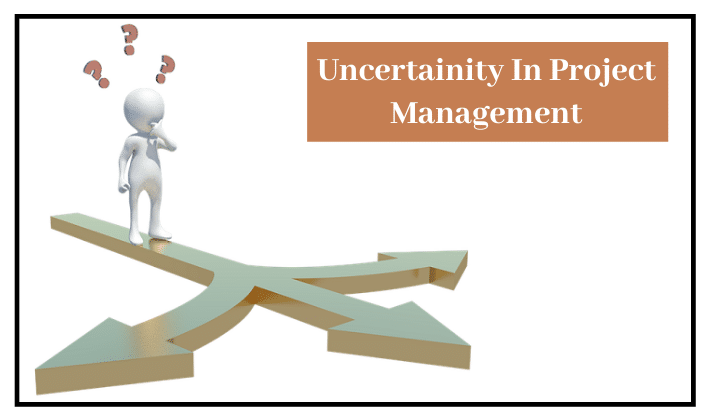You may not be familiar with the word uncertainty. In this article, we are going to learn about the uncertainties in project management.
This will be a beginner’s guide on “Uncertainty management in projects” that can also be considered as planning for the unknown.
WHAT’S IN IT
What is uncertainty in project management? Or What is project uncertainty?

Uncertainty is nothing but unpredictable events in the project. Here, the project is a particular work with a deadline (consider it as an assignment for you)
And here in this project or work, we will try to achieve something as output.
For example, There is an app development company,
It develops apps for different companies like Amazon, Flipkart etc.
Say a businessman went to that company and asked them to create an app for his travel agency,
And an agreement was signed between the businessman and that company.
The agreement consists of all the information and deadline to develop an app.
This is called a project for that app developing company.
Coming to uncertainty in this project scenario;
Let us consider a manufacturing plant which manufactures steel bowls.
It has a vast production line and a large number of workers are working for that company.
That company needs to produce at least 1 lac products per month, to avoid the loss.
Due to some issues, they could not make 1 lac products,
And they even don’t know the reason for this uncertain situation.
In uncertainty, the output of any task is unknown, it cannot be predicted or expected, you will not have any background information on the situation.
Uncertainty is not an unknown risk.
In uncertainty, you don’t have any prior information or knowledge about its cause, even if it has been identified.
But in the case of unknown risk, you will have the details (cause, info, etc), but you may miss them during the process of identifying risks.
We will discuss more in the project uncertainty and risk management section.
Sources of Project Uncertainty:
Let us understand with an example.
Say we want to establish a manufacturing unit in an already constructed building, and want to remodel that building.
We have to estimate the required efforts, for all these steps, such as Remodel building, etc.
Sadly, our estimation will not be exact. Estimates vary from reality because of uncertainties, which may come in many ways, or we can simply call them sources of uncertainties.
Most of the time, the uncertainties arise because of human errors like not considering a standard procedure or maybe neglecting some essential aspects.
Improper understanding of scope:
We may not have considered all the requirements. For example,
We may not consider few basic things like, Do we need to replace the baseboards?
If we don’t consider the replacement of baseboards, our plan is missing an important component, and our estimation will not include the work of replacing baseboards.
Incomplete understanding of effort for work:
Sometimes we consider the work properly, but we will have to consider them at the top level only and miss out on small processes/things included in the actual process.
For example, consider that we included baseboard replacement in our plan or scope, but we consider that the effort involved was limited to replace the new ones in the position of old ones.
Unfortunately, we didn’t count for the work required to measure and cut the baseboards to the right size and right shape. So, here even we estimated the scope correctly, but we failed to estimate the effort required and considered it as too low.
Improper Understanding of Known work:
Okay, for instance, consider that we estimated the effort also.
Even though we do remember all of the work that needs to be accomplished for the work of replacing the baseboards, and estimate correctly.
Our estimates may be wrong because some of the boards may damage while replacing. And we will either have to replace those baseboards again or need to drill them to avoid splitting when we attach them.
In both ways, the work will increase our estimation.
Unable to predict the unexpected:
Under this case, we have to question ourselves with “ what if?” or “ what happens if?”
What happens if the material we need is out of stock, or what if someone delivers the wrong baseboards? So these types of external events are uncertain and may deviate from our schedule.
Project uncertainty and risk management:

You already read about the uncertainty, and now we will look at “Risk.”
So many people get confused between the terms risk and uncertainty. But,
Risk can be an uncertainty, but the uncertainty cannot be considered as a risk.
Because the outcome of risk can be estimated/predicted, but it is not possible in the case of uncertainty
Example to explain the uncertainty and risk:
To make your vision clear about uncertainty and risk, I will try to explain them through a simple example.
First, we will look at risk;
Consider Two cricket teams with well-known players playing a cricket match.
Let the teams be Team A and Team B.
And you have to guess who is gonna win the match as you need to bid on them.
How can you do that?
There is a possibility that you can analyze the previous performances of the players, the current conditions like the pitch, weather, etc and take out the required result
Team A has 40% of winning chances, and Team B has 60% of winning chances.
And here, you placed your amount on Team B.
Here you have a 40% chance of losing and a 60% chance of winning. Here you can expect the positive or negative risk.
In the same sense, Consider Team C and Team D.
But here both the teams C and D are new teams and the players in both teams are in-experienced/freshers.
And you have to bid your amount on any one team.
What will you do now?
Here in this situation, you cannot predict the outcome.
And this is called uncertainty.
Uncertainty vs risk in project management:
Project Uncertainty vs Risk:
Uncertainty
Risk
You cannot predict the outcome here
You can predict the future outcome here
It cannot be measured and quantified
You can measure and quantify the risk
Uncertainties are hard to manage
Risks can be managed when compared.
How to manage uncertainty in project management:
Until now, we learned about the uncertainty and risk in project management and after finding the problem, we need to look at solutions or measures to control and manage this issue.
Follow these steps to manage uncertainties:
Understand the cause of the issue:

First of all, we need to understand the cause of uncertainty to make our next move.
Sometimes we think that the problems are big and hard to resolve, but after proper analysis, we may find it small.
So, we need to understand the actual problem thoroughly first
Finding the actual cause of the issue is also productive work because it will give a proper understanding of the cause and may suggest a solution that is suitable for the current problem.
Try to find issues fastly:
The project manager is the only person responsible for answering questions about uncertainty or risks.
This means he should analyze the problem or issue as quickly as possible, to know the extent of damage and difficulties that happened to the project.
He should offer a prescribed solution so that stakeholders can relax that the project can move ahead.
Keep the team updated on the progress:
Maintain good connection, communication, plan, and a pattern is necessary to gain trust and credibility.
Building trust, teamwork, and honesty in the project team is important because a good performing team will come together and try to resolve the issue.
Mark the issue as a solved for future projects:
Recording the experience and solution helps in your future projects to avoid facing the same problem again. Then this uncertainty can now be understood and can be documented as a known risk for future projects.
Conclusion
Uncertainty cannot be eliminated by estimation methods. It is caused because of two reasons they are; because of improper knowledge of “what to do” and “how long it will take,” and because of unexpected events.
Again, on average, these higher biases grow even when as many tasks are underestimated as over, extending the schedule beyond the sum of expected job durations.
Lessening scope helps to decrease the uncertainty, but only to a certain point. When the risk has been reduced as much as possible, the next action is to produce the method to cope with uncertainty. We have examined three strategies for managing uncertainty:
● For fixed-schedule and fixed-scope projects, add some time to the schedule. This is suitable for low-uncertainty projects, particularly those that repeat the same type of job many times.
● For fixed-schedule projects, use a quick process such as Scrum, and correct the extent in a planned way to reach the schedule. This is a better way to conduct a project. When estimates are bad, and scope is inadequately defined, and changes constantly occur, while still allowing for preparation and a helpful level of predictability.
● For unscheduled projects with unknown scope, uncertainty is very big, and planning is not reasonable. In this case, an approach such as Kanban, which targets on constraining work-in-progress, and it is effective
Also you can read our blog on The Most Useful Guide for How to Write a Business Case?
FAQ:
Uncertainties are nothing but the unexpected and unpredicted events that occur in the project.
Mainly there are 3 types of uncertainties, they are:
State-space uncertainty
Option uncertainty
Preference uncertainty
To know more details about these uncertainties
(source)https://eight2late.wordpress.com/2015/02/25/three-types-of-uncertainty-that-you-probably-overlook/
Uncertainty
Risk
You cannot predict the outcome here
You can predict the future outcome here
It cannot be measured and quantified
You can measure and quantify the risk
Uncertainties are hard to manage
Risks can be managed when compared.



